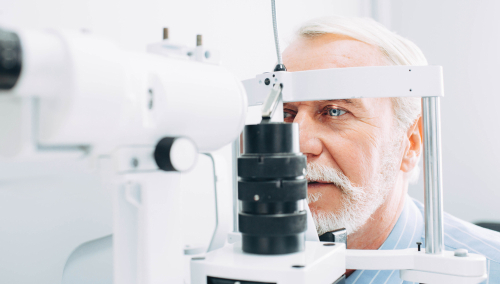
Glaucoma is one of the leading causes of vision loss worldwide. For this reason, the American Academy of Ophthalmology has designated January as Glaucoma Awareness Month.
Glaucoma is an eye condition that can cause irreversible damage to your sight without showing many symptoms. January is an excellent time for you to schedule a routine comprehensive eye exam to ensure your vision is not at risk.
An eye exam is the best way to detect glaucoma in its early stages. Keep reading to learn what causes glaucoma during Glaucoma Awareness Month!
What is Glaucoma?
Glaucoma is a group of eye conditions that damage the eye’s optic nerve. The optic nerve transmits visual information to the brain, allowing us to see.
Progressive damage to the optic nerve can lead to loss of vision if left untreated. Glaucoma often develops slowly and, in its early stages, affects just peripheral or side vision.
So those who have glaucoma may experience significant vision loss before they notice a problem or a change in their vision. Central vision, which is what we rely on to read, drive or watch TV, is usually unaffected until the eye condition is advanced.
The damage is most often caused by an increase in intraocular pressure (IOP), the inner pressure of the eye. Higher-than-normal IOP places pressure on the fibers of the optic nerve, causing damage and vision loss.
What Elevates IOP?
A healthy eye produces aqueous humor, a fluid that fills the front part of the eye. Normally excess fluid flows out through the eye’s drainage system in a consistent and stable manner.
A healthy eye is balanced between production and drainage. However, when the aqueous humor doesn’t drain properly, pressure build, pushing against optic nerve fibers.
Too much pressure and these fibers die off, resulting in vision loss. At this point, the loss is irreversible, and any sight you’ve lost is sight you can’t get back.
Types of Glaucoma
There are many different types of glaucoma, all of which typically require treatment to prevent vision loss. Primary open-angle glaucoma is the most common type. It occurs when the aqueous humor does not drain properly, causing IOP to increase.
Angle-closure glaucoma occurs when the angle between the iris and the cornea becomes blocked, preventing the aqueous humor from draining properly. Normal-tension glaucoma occurs when IOP remains within a normal range, but the optic nerve is still damaged.
Who Is Most At Risk for Developing Glaucoma?
Although anyone can develop glaucoma, certain factors may put you at higher risk for developing the eye condition. One of the most common factors is age, especially for those over forty.
Those with diabetes are also twice as likely to get glaucoma than those without diabetes. If you are very nearsighted, you also are more likely to develop glaucoma.
Having a family history of this eye condition also makes you more likely to develop it as well. For this reason, if you have a family history, your eye doctor may recommend regular eye exams to detect glaucoma early.
Although there is no cure for glaucoma, there are many effective treatments. Early detection can prevent the eye condition from worsening with options such as medicated eye drops and laser treatments to reduce pressure in the eye.
Do you want to learn more about glaucoma or determine if your eyes may be at risk? Schedule an appointment at Eyecare Medical Group in Portland, ME, today!





